The Sandhills Strategy -- Moving Pregnant Cows to Fresh Ground and Leaving Pairs Behind Can Limit Calf Sickness 🎙️
CLICK THE PLAY BUTTON TO LISTEN TO THIS POST:
Listen to more episodes on BeefResearch.ca, Spotify, Apple Podcasts, Amazon Music or Podbean.
There are many different methods of calving cows and there is no single perfect system.
For some producers, adopting the Sandhills Calving System has improved herd health and time management at a busy time of year. Named by a University of Nebraska professor who developed the idea, some refer to it as “leave behind calving,” the “drop-back method” or “strategic calving management.” The Sandhills System involves moving pregnant cows on to different “clean” ground while leaving freshly calved pairs in the field they were born in. This method helps minimize direct contact between older calves and younger calves and reduces the transfer of viruses and the build-up of disease-causing pathogens in the calving area. Regardless of what producers call it, moving pregnant cows to calve on clean ground and leaving freshly calved pairs remaining in their pasture is a practical way to improve health and reduce scours at calving.
During the 2021 Canadian Beef Industry Conference (CBIC) Bov-Innovation session, Dr. Elizabeth Homerosky, DVM, and Dr. Tommy Ware, DVM, both with Veterinary Agri-Health Services, discussed how they work with clients to map out different calving scenarios using common technologies like Google Earth. Seeing a situation from a bird’s eye view can help to highlight gaps and challenges in disease transmission specific to individual farms. Here’s a video clip from this session:
Whether producers are working with a limited land base and resources, or they can fully implement the Sandhills Calving System, the following profiles include many practical tips and takeaways.
A New Calving Concept for a Long-Time Ranch
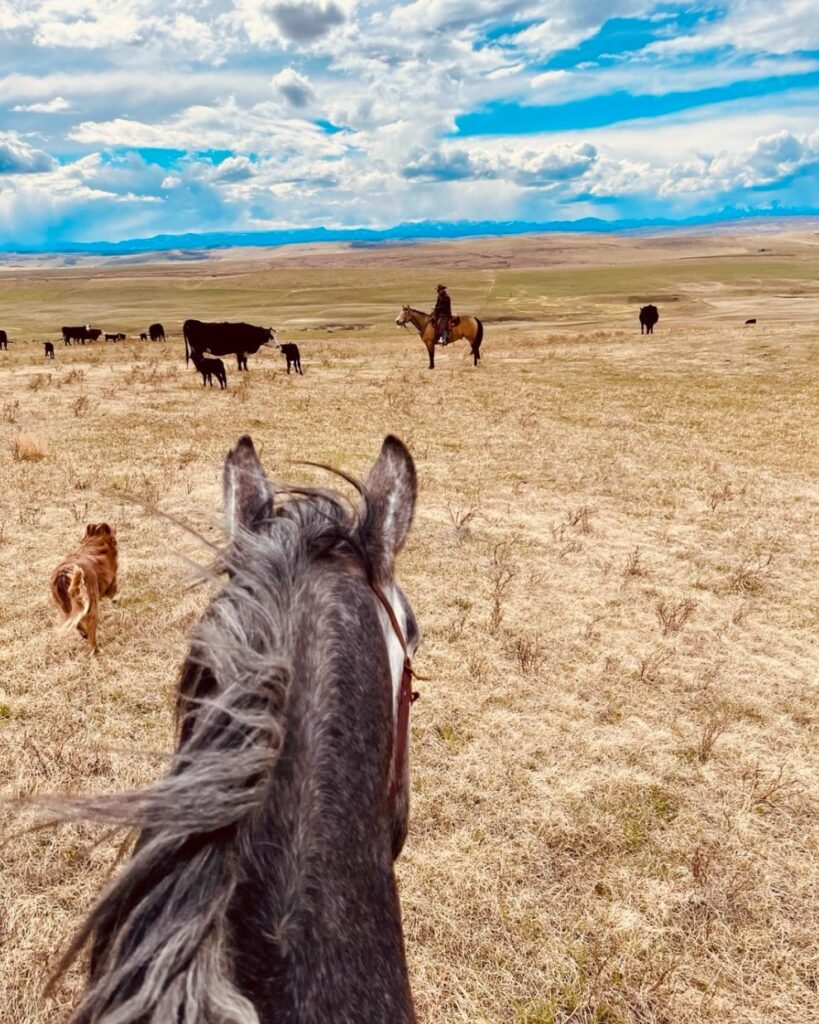
John Smith, who ranches west of Nanton, Alberta, tried the Sandhills System for the first time during the 2022 calving season, based on the advice of his vet clinic, Veterinary Agri-Health Services (VAHS).
At one time, the commercial Angus-based cow-calf operation calved in late February. “That can be pretty challenging so we kept dropping calving dates back and adapted some different practices,” Smith explains, saying they now use April 1 as a target start date and may consider moving it back later.
Up until this year, Smith says they used to “pair out” as cows calved, moving pairs to clean ground. After talking with VAHS, they decided to try the Sandhills method to reduce sickness in calves, and they moved his expectant females to fresh pastures in three different moves.
“I liked it. We’ll do it again,” says John. Like any new practice, he says there was a learning curve to determine how to manage pastures and make the best use of their facilities, but the reduction in sickness and treatment rates made it worthwhile.
“We had no scours, I had half or a third of a bottle of medicine from the year before and still have it,” he says. This was a much different outcome than what Smith experienced a couple of years prior when extremely wet weather during calving prompted a severe scours outbreak.
Smith kept his first-calvers together in a separate 60-acre field for calving. He maintains a strict 25-day breeding season to ensure calves arrive in a narrow window.
For the first big move sorting through soon-to-be moms, they had four riders. “We moved 300 cows and 100 stayed behind,” he says. Once the pregnant cows understood which pasture they were being herded to, John says they were eager to go.
“It happened fast; it only took an hour,” he says, but adds that he did have to take a bit of additional time the next day to clean up stragglers.
“It’s all about the health of the calves, about reducing death loss,” John says. “It saves time, too. There is a lot going on; it’s about making things easier.”
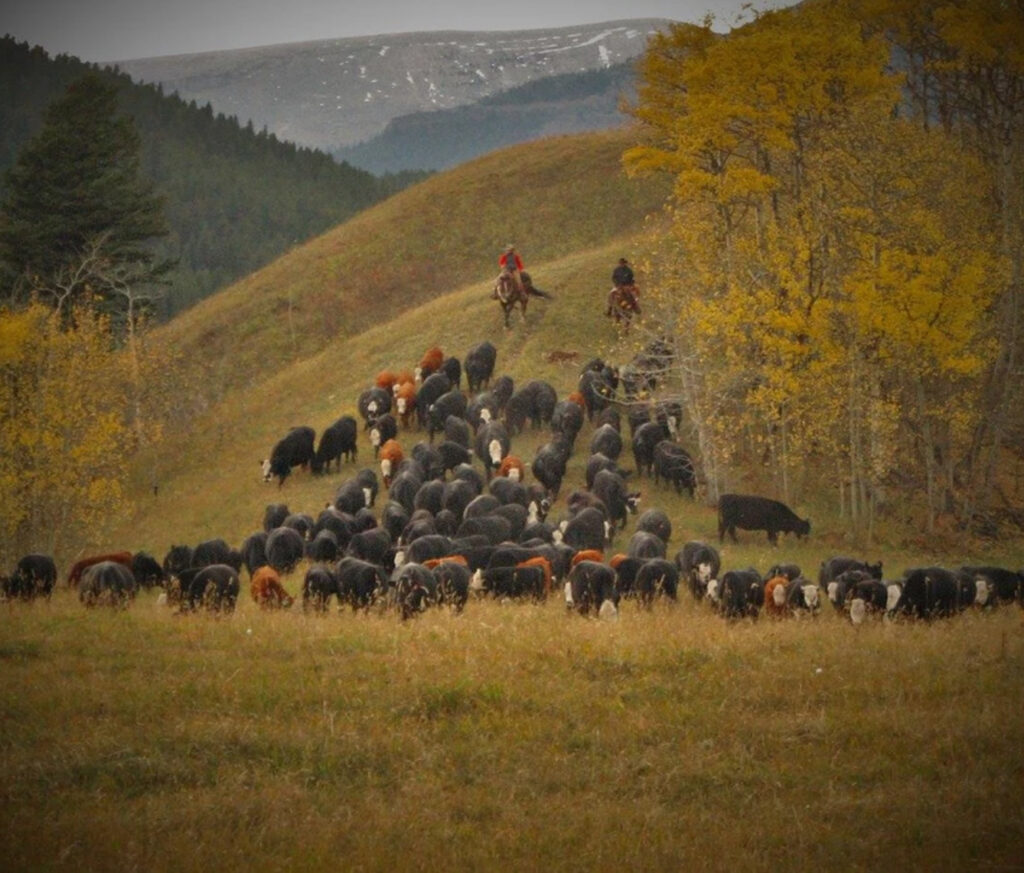
Consolidating all the pairs into one group took some planning. “We had three fields with quite a few pairs, actually four counting heifers,” Smith explains. “It felt like there were fields of cattle everywhere,” he says, but added there is an optimum timeframe to mix groups of cattle without having an adverse outcome, health-wise. They combined herds of cow-calf pairs during processing in May.
John tags his calves at birth, then at spring processing, cows and calves are vaccinated. “We don’t have a conventional branding, there’s no brand, but we do have pretty good management software,” he says, adding they use their record-keeping program to identify and sort individual animals through the chute as they process them in May.
John is looking ahead to future calving seasons, knowing that each year has its own unique circumstances and improvements will be made as needed. “I’m looking forward to year five or year seven in my rotation,” he says. “Get water set up properly, have a little more shelter, have the land set up, and make it a little handier.”
- Arrange your rotation strategically so that you are in a user-friendly field when you expect the most calves. “I tried to time it so that we were in the ‘calving field’ when weather was going to be bad or when I knew I’d get my max amount of births,” John explains. “It’s a bunch of cows, statistically enough can go wrong that you might need to be reasonably close to facilities.”
- Even if you aren’t set up to change your calving method, consider moving infrastructure to avoid the build-up of disease-causing pathogens. “We have a lot of portable windbreak and calf huts, and move them around more often, that is probably improving health as well.”
Drop-back Calving on a Large Scale
Kelsey and John Beasley operate Integrity Ranching near Youngstown, Alberta. These livestock producers are continually evolving and currently run a yearling and sheep operation. At one time, they calved 900 cows using the Sandhills Calving System. “We’ve always been learning, that was why we did the drop-back calving,” says Kelsey.
“We were running a cow-calf and yearling place at Boggy Creek, in Manitoba,” she says, and adds the climate was the biggest challenge. “It was colder and there were longer winters.” Scours management was a big concern. After reading about the Sandhills method, they talked it over with their farming family members and decided to implement it.
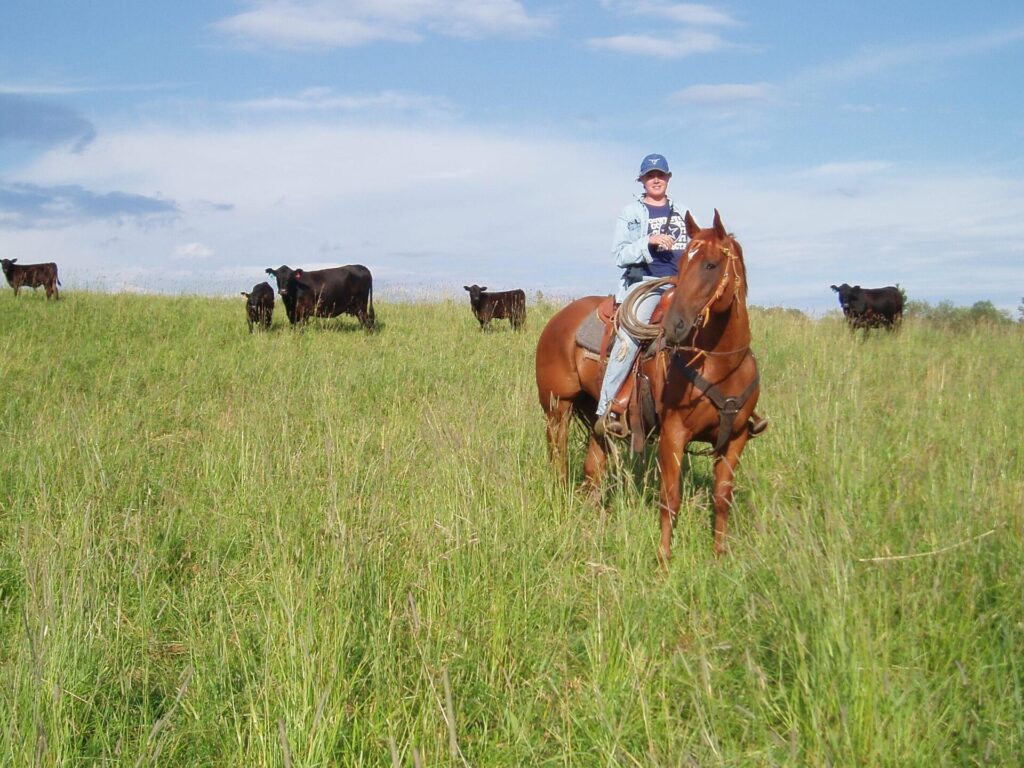
“We were shifting to a later calving on grass in May and June versus the end of April,” she says. They grouped the herd into replacement heifers with second-calvers and then the main cow herd.
“The success was really in the planning out of the grazing system,” she explains. They were incorporating bale grazing and the cows came out of winter pastures with stockpiled grass before transitioning to calving. “The timing of year is huge, you have to have a good forage supply that’s matched to the requirements of the animals,” she says.
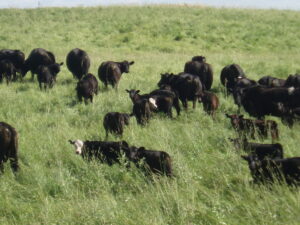
“Once we had a good-sized group of calves on the ground, maybe 150 or 200, we would go out early at daylight, ride through, and when those calves got up to suck, we just moved all the ‘uncalved’ cows out into the next field,” Beasley explains.
Kelsey found that there were few risks but plenty of benefits to drop-back calving. “Disease load-wise, you have those neonates on clean ground,” she says and adds that the herd had much better health with no issue of scours.
“I would say you also got to be pretty handy with stockmanship,” says Kelsey. “You’re not fighting with those young pairs, you can give that cow time to just be a cow.”
- Timing and stockmanship are key when moving pregnant cows on. “You will have your best success moving cattle as close to daybreak as possible compared to if you wait until mid-day or afternoon,” says Kelsey. “You want to be ready to move first thing in the morning when the calves get up for their first suck, the pairs will naturally be situated and easier to leave back at this time.”
- “If you missed some cows, don’t sweat it.” Beasley says you can almost expect to have a couple of cows that get left behind, especially if they aren’t used to the system yet. “Check that group first, snag your opportunity for the ones you missed,” she says. “Just be cool about it, take it easy, gather them up and move them.”
- Rather than combining all the pairs, you can streamline spring processing by working the separate groups of cow-calf pairs. “At the end of calving, we had all these groups sorted by age and also had all the dries sorted off,” Beasley says. “It was so efficient in time and saved us in labour,” she says, adding that when it came time to brand the calves, each separate group was the same age.
Implementing the Sandhills System in the Sandhills of Saskatchewan
Erin McKnight and her husband Steve raise commercial cattle in southern Saskatchewan. A portion of their ranch is comprised of tame grass pastures and farm fields that they use to grow greenfeed, but the majority of their operation is rough sandy rangeland.
In the past, they used to calve cows out in large, rugged sandhill pastures but that presented a few challenges. “In the Sandhills, it’s really tough to see what’s going on,” Erin explains. “On this ranch, there’s always been a pilot,” she explains, and Steve often relies on his plane to help determine what’s happening on the land.
Over time, they shifted toward calving on flatter, smaller fields. “We calve all our pairs in the spring in April and May, then we push them out to grass in the sandhills after they’ve been worked in the spring,” says Erin.
After deciding they preferred working fewer smaller bunches of calves at spring processing rather than having a single large round-up, they started pushing pregnant cows to different fields, leaving pairs behind.
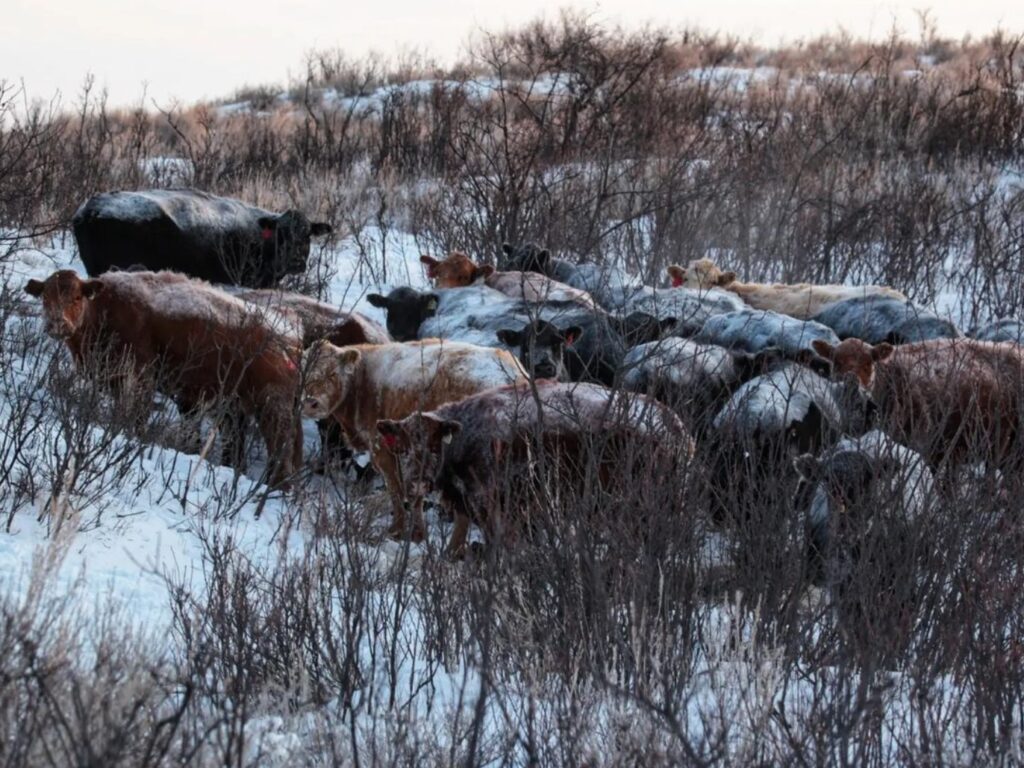
“We just stumbled on that,” says Erin. “It was naturally what we started doing and it was a couple years after we started doing it that we both learned that this is studied and an actual system,” she explains. “Ironically, it is called the Sandhills System.”
They start with a group of several hundred pregnant cows in the beginning and with each move, the group gets smaller and smaller. “We let pregnant mamas move off and the cows that had babies would linger back,” she describes. “It’s never a perfect split,” she notes but adds that they take care to move pregnant cows out of the pairs at processing time to ensure their future offspring get vaccinated in the next bunch.
The health of newborn calves and the time savings has made this method work for the past eight calving seasons. “We can work those bigger calves sooner and it helps us get those cows out to summer pasture quicker. It works for us out here. It works for our situation.”
- Find a system that works for you to streamline labour and time. “We used to ride in the giant Sandhills fields and spend hours and hours in the saddle,” says Erin. The Sandhills System has enabled the McKnights to work groups of same-age calves effectively. They still log plenty of miles on horseback but in a different way. “We work them in smaller groups, not just one big branding, where there is too much stress and too much confusion,” she says.
- Provide natural or man-made shelter for calving cows. “We need to provide cover for our animals all year long but especially during calving season,” says Erin. She adds that in their situation, there’s a balance to strike where they want to make use of pastures with natural protection such as brush and trees, but avoid using pastures for calving where the terrain is too rough.
Modify Management to Reduce Contamination at Calving
Dr. Lance Males, a large animal veterinarian at Temiskaming Veterinary Services in New Liskeard, Ontario, says that when space is limited, clean bedding is the key. “Have enough bedding that calves don’t have access to a ‘manure meal,’” he says. “Udders must be clean and dry.”
Males refers to the first three weeks of calving season as the “honeymoon” period, where producers may not experience a lot of scours. During this period, disease-causing agents are still multiplying in the guts of young calves before they build up in the environment, ready to infect others. Reducing stock density and moving the cow herd to clean ground on a regular basis can prolong the honeymoon phase.
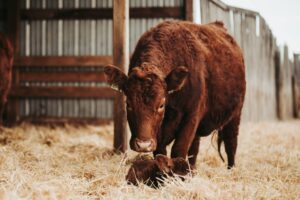
“The Sandhills calving scheme is great, but you may need to modify the concept if the farm only has one calving area,” Dr. Males explains. In situations where winter calving herds have limited space and use a single common handling area for calving cows, producers may opt to move pairs to different yards or pens.
One client he worked with would calve cows in freshly bedded pens. “All the calves older than a day were moved with their dams to a nearby yard to be fed,” he explains. “This left the producer with a couple of yards [or pens] of calves outside, with each yard containing calves that were born within a week of each other,” he says. “Once the youngest calves in a group hit three weeks of age, they could be combined with older groups and moved to a larger nearby bush lot.”
If producers have the space and option to utilize summer calving, Males says it can be an effective way to reduce scours and other sicknesses, as well as decrease labour. “With lots of space, newborn calves experience a reduced disease challenge and subsequently lower treatment rates,” he says. “There is less risk of freezing, lower bedding requirements, calves tend to be born a bit lighter, so fewer calving difficulties,” he concludes.
- If a farm is going to the work of separating calves in their pens by birth week, they need to avoid fence line contact between young and older calves. “You need a few metres of physical separation or else the results will be disappointing,” Males suggests.
- The greater the age range between the youngest calf and the oldest calf, the cleaner the yards or pens need to be. “Assume the older calves are shedding significant numbers of pathogens, so additional straw and a large area can reduce the likelihood of a newborn calf being exposed to it.”
Learn More
- Proper Management is the Key to Minimizing the Risk of Calf Scours (BCRC post)
- Calf 911 Resources – Emergency Support for Newborn Calves (BCRC post series)
- Calf 911 Checklist (BCRC checklist)
- Calving and Calf Management (BCRC topic page)
- How Fresh Pens and Pastures Prevent Calf Losses (BCRC post)
- Steps to Reduce Disease in Newborn Calves (BCRC webinar)
- Tightening the Calving Season: How to Increase Profitability Through Calving Distribution (BCRC video)
Sharing or reprinting BCRC posts is welcome and encouraged. Please credit the Beef Cattle Research Council, provide the website address, www.BeefResearch.ca, and let us know you have chosen to share the article by emailing us at [email protected].
Your questions, comments and suggestions are welcome. Contact us directly or spark a public discussion by posting your thoughts below.